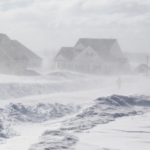Not All Sunrises are Created Equal
Why does the Sun rise at different times in different places? Find out!

If you open up your Farmers’ Almanac (you do have a copy, right?) to the calendar section that contains many pages of astronomical data, you’ll see entries listing the sunrise and sunset times for each day of the year. The only problem is, depending on where you live, those time may not be accurate for your area. What gives?
The sunrise and sunset times listed in the Farmers’ Almanac are for a specific geographic location:
- 40° N Latitude and 75° W Longitude for northern US states
- 35° N Latitude and 90° W Longitude for southern US states
These are chosen because data suggests that the population is densest near those areas. The further you live from those exact coordinates, though, the more drastically your local sunrise and sunset times might differ from the published times.
Variables That Affect Sunrise and Sunset Times Where You Live
That’s because sunrise and sunset times depend on a number of variables, including longitude, latitude, altitude, and location in relationship to your specific Time Zone. Here’s a look at how each of these factors affects your area’s sunrise and sunset times.
Longitude
Longitude lines are the imaginary lines that run vertically around the globe, intersecting at the North and South Poles. Longitude is a way of talking about how far east or west a location is in relationship to one specific imaginary line, called the Prime Meridian, that runs through the town of Greenwich, England. Because the Earth spins clockwise, the Sun appears to the east of any given location each day. It takes about one hour for the Sun’s light to move 15° longitude. This is why the Sun’s rays reach the East Coast each day before the West Coast.
Time Zone
Time zones were created to acknowledge the fact that the Sun is not “up” at the same time everywhere around the globe. Because the Sun’s light moves across the Earth at a rate of 15° longitude per hour, people divided the Earth into 24 roughly equal sections of about 15° each, and assigned a one-hour time difference to each successive zone. This means that, all other things being equal, the Sun rises at roughly the same time no matter which time zone you’re in. Unfortunately, it’s not quite that simple. First of all, the many time zones don’t line up perfectly with the longitude lines, due to political and other complications. In addition, not all of us live right at the easternmost edge of our respective time zones. The further west you live within your time zone, the later your sunrise will be. There is a simple, but somewhat inexact, way to figure this out. For every 70 miles you travel west within your time zone, sunrise will be about four minutes later. This time decreases somewhat the further you move from the Equator, though. That’s because of latitude …
Latitude
Latitude lines are imaginary lines that encircle the globe horizontally. Latitude is a way of talking about how far north or south a location is in relationship to the Equator, the imaginary line that runs around the center of the globe. Unlike longitude lines, latitude lines never intersect. Because the Earth’s circumference is smaller near its poles than it is around its center, extreme northern or southern locations experience greater variations in the length of their days than locations closer to the Equator. While equatorial locations get approximately 12 hours of daylight and darkness each day, year-round, areas closer to the North and South Poles can experience several months of constant sunlight or darkness at a stretch. Most North Americans live somewhere between these two regions.
Altitude
As if all of these factors weren’t enough, altitude also plays a role. Generally speaking, the higher your location is, the earlier the Sun will rise, and the later it will set, compared to when it would for the same location if it were at sea level. An easy way to determine what effect altitude has is to remember than sunrise will be one minute earlier for every mile of altitude, and that sunset will be later by the same amount.
Calculating Adjustments
If you check page 128 of the 2025 Farmers’ Almanac, here’s how to adjust the sunrise and sunset times listed in the Almanac’s Calendar Pages (pp. 132-163 to your location. To find your exact location coordinates, try this finder.
- The times for the rising and setting of the Sun and Moon are calculated for an observer located exactly on one of these standard meridians (in North America):
- Eastern: 75 ̊ W
- Central: 90 ̊ W
- Mountain: 105 ̊ W
- Pacific: 120 ̊ W
If your longitude is very close to one of these, then luck is with you, and you can use our printed times for the rising and setting of the Sun and Moon without any correction.
- If your longitude is different from one of these standard meridians, you need to add four minutes to the times listed on the Calendar Page for each degree of longitude that you are west of your time zone meridian. Or subtract four minutes for each degree you are east of it.
- For example, Boston, Massachusetts (longitude 71 ̊) is 4 degrees east of the Eastern Time meridian. So, for Boston, subtract 16 minutes (4×4) from the times obtained from the Calendar Pages. The result is in Eastern Standard Time or Eastern Daylight Time, depending on the time of year.
The above calculations will yield approximate local times for the rising and setting of the Sun and Moon, but will ignore the less important difference between your latitude and those of the Calendar Pages (35 ̊ and 40 ̊ North), as well as the character of your local horizon.
Some Interesting Sunrise and Sunset Times Across The US
Mars Hill, Maine, experiences the earliest sunrise in the contiguous United States, with the Sun coming up at 4:38 a.m. during mid-June each year. Mars Hill is not always the first place to see the Sun year-round, though. During the winter months, Cadillac Mountain, near Bar Harbor, Maine, sees the Sun first, while that honor goes to Quoddy Head in Lubec, Maine, as the equinoxes approach.
The earliest sunset of the year happens in Bar Harbor, Maine, where the Sun goes down at 3:44 p.m. during early December.
Fortuna, North Dakota, which sits far to the west of much of the rest of the Central Time Zone, bears the distinction having of both the latest sunrise and sunset of the year in the contiguous U.S. There, the sun rises at 8:48 a.m. in late December. In mid-June, the sun doesn’t set until 10:03 p.m.
Of course, Fotuna is not the last place in the U.S. to see the Sun go down. That happens in Cape Flattery, Washington, the northwesternmost point in the contiguous U.S. Because Cape Flattery isn’t as far from the eastern edge of the Pacific Time Zone as Fortuna is from the eastern edge of its time zone, sunrise and sunset times come a little earlier there. Its latest sunrise occurs at 8:09 a.m. late December, and the latest sunset happens at 9:23 p.m. late June.
Two other U.S. areas fall at the extreme western edges of their respective time zones. Ontario, Oregon, in the Mountain Time Zone, sees its latest sunrise at 8:22 a.m. in late December and its latest sunset at 9:34 p.m. in mid-June. Ontonagon, Michigan, in the Eastern Time Zone, has its latest sunrise at 8:42 a.m. in late December and its latest sunset at 9:55 p.m. in late June.
Of course, all of this pales in comparison to Barrow, Alaska, where the Sun stays down from November 20 until January 22, and stays up from May 12 until August 1 each year! A bit further south in Anchorage, mid-winter days are only five and a half hours long. The Sun comes up at 10:15 a.m. and goes down at 3:42 p.m. there.

Jaime McLeod
Jaime McLeod is a longtime journalist who has written for a wide variety of newspapers, magazines, and websites, including MTV.com. She enjoys the outdoors, growing and eating organic food, and is interested in all aspects of natural wellness.












Hello… my friend that has been living in Wyoming for 20 years plus has noticed that the sun rises and sets in different locations than it used to on same dates..!!And also that the sun rises earlier and also the sun sets later…once again on same dates.His home and neighbors homes and trees where not moved.This proves that the Earth has actually moved some and we are thinking perhaps that the 2004 Indonesia tsunami may have threw the earth of coarse a bit ….unless it is some kind of natural cycle the earth goes through every so many of thousand years,etc.This would also throw off the magnetic north point.Not much seems to be talked about at all anywhere that I can research.
The planets are in rotation of the earth and we travel 1 thousand miles away from home and turn around and head back 1 thousand years since I have all the keys I know when we turn and go home while no one else knows where we are going. The devil doesn’t know either nor his heathen friend and fa
There is the earth’s polar shift that is on the way that no one seems to talk about that is the main reason. I live in the same home for the past 23 years and the sun sets from a different location in June than it used to 23 years ago. The earth has tilted
Being on the very East end of a time zone (I am Central but one county over is Eastern) I’ve always HATED our early sunsets! It really isn’t that hard to understand but I have a difficult time explaining this to friends and family. Our “local” TV stations are in Marquette MI which is eastern. Everything they say is ET based. The summer sunset times they state are very late. I’m NOT a morning person so I couldn’t care less about sunrise time. When I talk to ppl about our stort winter afternoon daylight I swear I’m talking to a block of wood! We’re also quite far north (44N) so our winter days are short enough!! It’s not surprising how common S.A.D. is in this area once while traveling through in Alberta CA in mid June we were generally using the sun to judge when it was time to find a hotel. Imagine our surprise when we realized it was WELL After 10pm yet still not yet dark. VERY surreal.
Here in Maine, we are the Easternmost part of the Eastern Time Zone (and pretty far north!) and when it is dark at 4pm – it is rough! We hope you find some light this winter!
The time given for sunrise today in my location was 6:46 am. The sun did not appear for nearly three quarters of an hour, a little before 7:30 am. I was puzzled by this so I went looking for an answer. This is the only explanation I found. The curious thing is that the criteria for determining when sunrise would be was my zip code and the sun didnt appear til long after the time given. Is this an example of what you describe? Though my location was pinned by my zip code, the time given was actually for when the rising sun hit the edge of the time zone I am in? If not I am realy confused by this. Thank you!
Check the Wikipedia article on sunrise. It’s hard to determine the time of sunrise by watching the horizon!
If the horizon isn’t flat in your location, meaning that there is a hill, mountain, building, etc between you and the point where the sun rises on the horizon, you may not see the sun for some time after the published sunrise time, which does not account for local topography.
The earth spins counter-clockwise.
That is, when viewed from above the north pole.
dear sir
i was wondering whether there might be an official graph that plots the relationship between altitude and sunset provided by the national metereological society or US Navt etc for any given place on earth during the course of the year as simple as possible!!!
please steer me in the right direction!
thanks
thanks
Rabbi Gettinger
Rabbi Gettinger,
I don’t know of one, specifically, but if you consult with e agencies you mention, you may find one.